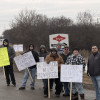Each year, Boilermaker scholarship candidates must answer an essay question and topic prompts as part of the application requirements. The question is different each year, and candidates must respond in 500 words or less.
The 2024 Boilermakers Scholarship Essay question was:
What economic conditions fueled the rise of labor unions in the late 19th and early-to-mid 20th Century? Compare and contrast the economic conditions from that period in history with conditions workers face today. Include topics such as wages, housing costs, safety, child labor or others.
Following are the essays* as submitted by Khylle Felisilda, winner of Canada’s Edward Power Scholarship, and Alexander J. Hogston, winner of the U.S. Charles A. Jones Scholarship.

By Khylle Cristie Felisilda
daughter of Peter P. Felisilda, L-D359, Edmonton, Alberta
Five years ago, I was invited to preview a local high school’s rendition of Oliver Twist, a story that encapsulates the atrocious working conditions of children in Victorian England—widely known as the plight of the poor during that time. While watching the play I felt a sense of outrage and sympathy as I witnessed the experiences of the young orphan children: neglected, abandoned, and tackling feelings of hopelessness and helplessness. It made me question, how did this happen? Why did this happen? How can we prevent this from further exacerbation?
The origins of the Industrial Revolution are rooted in the economic transformation of Great Britain in the 19th Century. At this time, the economic ideas of classical liberalism had escalated across Europe, leading to the development of factory systems, innovative technology, and rapid urbanization. However, while new methods and mechanizations introduced significant positive changes in producing goods and services, poor working and living conditions stimulated a deterioration of the quality of life for most of the population. Factory owners had little sympathy for workers who were simply seen as necessary components of the production process. Under laissez-faire capitalism, the government was not involved in the economy and therefore, placed no restrictions on economic production. As industrialization continued, workers began to call for reforms. Suffering from low wages, dangerous working conditions, and frequent unemployment, workers protested violently against corporations.
Workers sought an equal voice that represented their demands. They increasingly advocated for equal opportunities and respect for all members of society, leading to the birth of labour unions. During the 19th Century, several labour laws were introduced to the public including freedom of association, outlining the right to organize and negotiate collectively. They strongly believed that if workers in a specific trade banded, they could advocate for better hours and wages and threaten to strike if their interests have not been fulfilled. This challenged the prevalent notion that labourers held a lower status in society.
Today, millions of workers are forced to accept inadequate working conditions. The global labour movement has witnessed a resurgence in recent years mainly because more and more employees are stipulating for better wages, benefits, and safety. Workers continue to suffer from unfair conditions such as being forced to work in hazardous environments with limited safety training resulting in physical and mental exertion. Hence, this proves that the modern-day world has yet to experience significant improvements concerning workers’ rights. However, since the Industrial Revolution, there have been improvements including the prevalence of women and racial minorities in the workforce, enforcing stricter child labour laws, and implementing several employee benefits.
In summary, unions are largely responsible for stimulating growth in the economy. They were established to create better representation for individuals in the workforce by protecting employee rights and eradicating exploitation. Ultimately, there is still a profusion of room for improvement in today’s economy; however, conditions today have drastically ameliorated since the 19th Century.

By Alexander J. Higston
son of James R. Hogston, L-105, Chillicothe, Ohio
With the explosion of discoveries and inventions in the late 1800s, the United States underwent an unmistakable technological revolution. Mass production became standard for most businesses. There was an upsurge in steel manufacturing, electricity distribution, and railroad construction. As America’s economy began booming from expanding markets, there was a growing issue behind the scenes. The class gap between the wealthy and the poor was growing exponentially. The rich were becoming more affluent and influential from the support of prosperous industries. The poor suffered financially and physically from their newfound conditions in the industrially dependent world.
It was no secret the working class was being exploited and abused for the benefit of companies who hired them. Annual salaries barely amounted to $600. Employees could not support a family without working more than 12 hours daily. Working conditions were hazardous and deadly in many cases. Machine-related injuries and diseases from unsanitary workspaces were commonplace. Overseers of these workers completely disregarded employees’ well-being. The worst practice in almost every mass-production factory was the use of children younger than 16 for textile jobs, along with paying them a fraction of what regular workers received.
One of the most horrific cases of worker neglect was the Triangle Shirtwaist Fire. Owners of the factory had locked the fire escape routes, and 146 workers, primarily young women, were killed. Accidents like this sparked widespread activism and protests against child labor and the disregard for low-class workers. Throughout the 1900s, whistleblowers exposed extreme and illegal practices. Over time, unions began to form. Employees were no longer allowing the abuse. The voice of one is faint, but the voices of many demand attention. With the help of union representatives, they started negotiating long-term contracts with the corporations. Unions helped ensure workers received superior benefits and guaranteed the safety and rights of every union member.
The advantages of these longstanding unions are still seen today. Employees can secure safe working environments with a considerable wage through collective bargaining and contract negotiations. They have benefits that 1900s workers could only dream of, including pensions and medical coverage. Union members can voice concerns and opinions without jeopardizing the security of their jobs or, worse, their livelihood. It has been the best resolution to fight the abuse of large businesses and corporate greed. However, even with the increase in workers’ authority, some companies still run on exploitation.
Companies without union representation continue offering their employees little to no benefits, with working environments barely meeting health standards. The difference between these corporations and those in the late 19th century is their keen ability to hide disagreeable business practices. Fortunately, unions have made significant progress in attaining the rights and safety of all workers. Unions like the International Brotherhood have provided safe and lucrative jobs to members like my father and continue to fight against cruel enterprises that have no care for the working class, on whose backs this country was and is being built.
*Editor’s note: These scholarship essays are the original work and independent thought of student authors.





